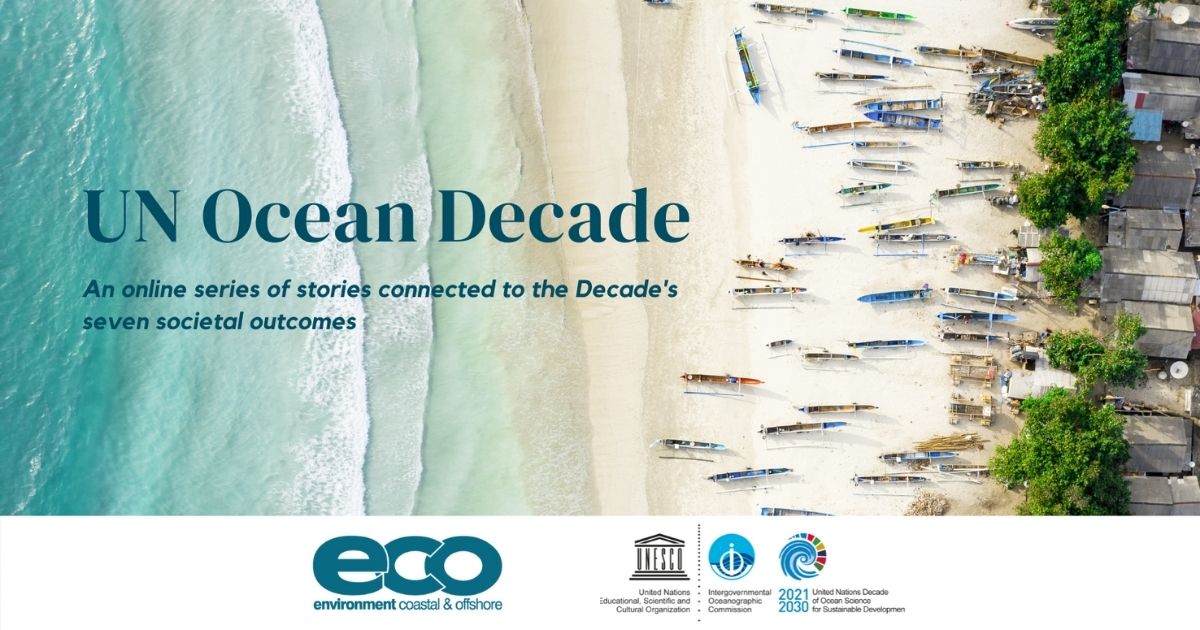Conducting tsunami simulation exercises to increase preparedness for real tsunami events
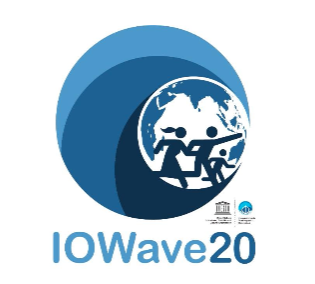 The 2004 Indian Ocean tsunami generated offshore of Banda Aceh, Indonesia, was the deadliest tsunami in history, with over 230,000 causalities across 14 countries. In response to this tragedy, UNESCO/IOC was given the mandate to develop new tsunami warning and mitigation systems in the Indian Ocean, Mediterranean and North Atlantic, and the Caribbean and maintain the existing system in the Pacific Ocean. As a result, the Intergovernmental Coordination Group for the Indian Ocean Tsunami
The 2004 Indian Ocean tsunami generated offshore of Banda Aceh, Indonesia, was the deadliest tsunami in history, with over 230,000 causalities across 14 countries. In response to this tragedy, UNESCO/IOC was given the mandate to develop new tsunami warning and mitigation systems in the Indian Ocean, Mediterranean and North Atlantic, and the Caribbean and maintain the existing system in the Pacific Ocean. As a result, the Intergovernmental Coordination Group for the Indian Ocean Tsunami
Warning and Mitigation System (ICG/IOTWMS) was established through IOC Assembly Resolution IOC-XXIII-12 (2005). Recognizing the importance of tsunami exercises as a means to test the tsunami warning systems while increasing education and readiness, UNESCO/IOC conducted its first basin-wide exercise in the Pacific Ocean in May 2006. Six Indian Ocean Wave (IOWave) Exercises have now taken place in 2009, 2011, 2014, 2016, 2018 and 2020. The exercises have been designed to test the receipt and dissemination of tsunami notifications through the tsunami warning chain as well as appropriate responses aligned with pre-established standard operating procedures. Examination of exercise progression in the region benchmarks the status, progress and milestones of the Indian Ocean Tsunami Warning and Mitigation System.
Tsunami simulation exercises are a very effective tool for creating tsunami awareness and preparedness among stakeholders. The purpose of tsunami exercises is to evaluate the stakeholders’ readiness and identify changes that can improve their effectiveness. The exercises emphasize testing of communications from a warning center to its stakeholders, and provide an opportunity for testing national/state/local chains of command and decision-making, including the alerting and evacuation of people from selected coastal communities.
Exercise Coordination
For each IOWave Exercise, the ICG/IOTWMS Steering Group convenes a task team to coordinate the exercise. Key responsibilities include exercise planning and preparation of the exercise manual and report. The task team ensures that the lessons of past exercises are incorporated into the design of future exercises by citing national inputs regarding exercise improvements as captured in post-exercise evaluations and lessons learnt workshops. IOWave task teams are comprised of members nominated by Member States and representatives from the Tsunami Service Providers (TSPs).
In order to ensure that the commitment of participating Member States is fully coordinated, each participating country nominates a National Contact for the IOWave Exercise. The designated National Contact confirms the accuracy of existing tsunami warning arrangements within their country and coordinates input to the exercise evaluation.
The ICG/IOTWMS Secretariat supports the IOWave Exercises by facilitating meetings of the task team, assisting in publishing the exercise manual and report, and administering the post-exercise evaluation survey. Further support is provided by the Indian Ocean Tsunami Information Center (IOTIC) through pre- and post-exercise regional workshops, the logo designs, a dedicated IOWave website, and archives of national media coverage of the Exercise.
The Pre-IOWave regional workshop on Standard Operating Procedures (SOPs) on Tsunami Early Warning and Emergency Response was organized to sensitize the IOWave exercise and review, update, and enhance the Tsunami Early Warning and Emergency Response of the member states. Mostly these Pre-IOWave SOP regional workshops involved the National Warning Centre and the Disaster Management Offices (National and Local). However, several workshops also involve broadcasting media. The Post IOWave Exercise regional workshop helped to quickly review the exercise, compile lessons learnt and good practice, as well as provide recommendations for the next IOWave exercise. These recommendations offered insights to help IOWave evolve and progress to better serve the member states in conducting exercises.
International observers have made key contributions to the more recent exercises. For example, IOWave16 saw international observers deployed to India and Seychelles. During IOWave18, international observers were deployed to Iran and Sri Lanka. In the most recent exercise, IOWave20, observations of exercise participation were conducted virtually in Indonesia, Sri Lanka and Pakistan.
Exercise Evolution
Although the objectives of each IOWave exercises seem to be similar, they each went through several major changes: shifting of tsunami notification providers’ responsibility, changes to the source of an earthquake as the scenarios for the exercise, the increasing number of exercise scenarios, and the scheduling of the exercises. All these phases were progressed to better facilitate the member states to complete the exercises.
The first Indian Ocean Exercises, held in 2009 and 2011, replicated the earthquake parameters of the 2004 Indian Ocean tsunami, placing many but not all Indian Ocean Countries under threat. The exercises highlighted the transition from the tsunami advisory service to three Indian Ocean TSPs. When the Indian Ocean Tsunami Warning and Mitigation System commenced in 2005, the issuance of tsunami notification bulletins at the regional level was the responsibility of the Interim Advisory Service (IAS) consisting of the Pacific Tsunami Warning Center and Japan Meteorological Agency. This was the case during the 2009 exercise; the IAS issued exercise bulletins to the Tsunami Warning Focal Points (TWFPs) of each Member State. The three Regional Tsunami Watch Providers of Australia, India and Indonesia shared experimental bulletins between themselves. The 2011 exercise coincided with the commencement of the tsunami service for the Indian Ocean by Australia, India, and Indonesia, who sent bulletins directly to the TWFPs during the exercise.
Known as the Tsunami Service Providers (TSPs), Australia, India and Indonesia assumed full operational responsibility for the Indian Ocean and the IAS ceased on 31 March 2013. Therefore, since the 2014 exercise, all tsunami bulletins have been issued solely by the TSPs. These subsequent exercises tested preparedness for alternative events, diversifying the locations and increasing the number of scenarios.
The next three exercises, held in 2014, 2016 and 2018, all involved two scenarios: one located along the Makran trench and the other located offshore of Indonesia (i.e., in the Java trench and Sumatra trench). The exercise was conducted on two consecutive dates.
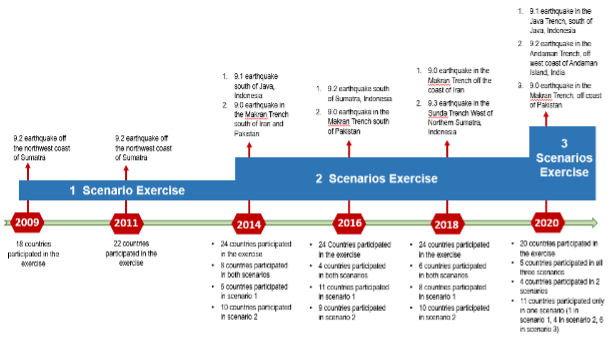 Figure: The evolution of the IOWave exercises in terms of number of scenarios used in the exercise and different date of the exercises allow member states to have more options in the exercise (i.e., based on the impact of the scenario to their country as well as to participate in one, two, or three exercises).
Figure: The evolution of the IOWave exercises in terms of number of scenarios used in the exercise and different date of the exercises allow member states to have more options in the exercise (i.e., based on the impact of the scenario to their country as well as to participate in one, two, or three exercises).
In 2020, the most recent exercise comprised of three scenarios: Java trench, Andaman trench, and Makran trench, placing the entire Indian Ocean basin under threat. The scenarios were conducted one week apart and allowed the individual Member States to decide the type and number of exercises to participate in.
Participation in multiple exercise scenarios, at least at the NTWC and NDMO level, had the advantage of allowing standard operating procedure issues identified during the first exercise to be corrected and exercised again. It also encouraged the testing of different elements of the standard operating procedures because the tsunami arrival times were varied for each scenario.
Engaging Coastal Communities
Throughout the IOWave Exercises, the engagement of coastal communities in tsunami education campaigns, preparedness measures, and evacuation drills has grown. Moreover, awareness and adoption of the Tsunami Ready guidelines have increased.
During IOWave09, three countries executed the Exercise at the community level, and this increased to four countries in IOWave11 and then slightly decreased to two countries in IOWave14. From 2016 onwards, there was a big push to involve communities in IOWave exercises, which resulted in twelve countries participating in community evacuations during IOWave16 and eleven during IOWave18. However, during Exercise IOWave20, the number of countries involving communities decreased to six, which is attributed to scaling back the exercise because of the ongoing Covid-19 pandemic.
Key milestones in exercise participation were achieved during the 2016 exercise where over 60,000 people evacuated and subsequently during the 2018 exercise where over 119,000 people evacuated. The vast majority of community evacuations were conducted in India, with Australia, Comoros, Indonesia, Iran, Kenya, Mauritius, Oman, Pakistan, Seychelles, Sri Lanka, Tanzania, Thailand, and Timor Leste also involving coastal communities in one or both exercises.
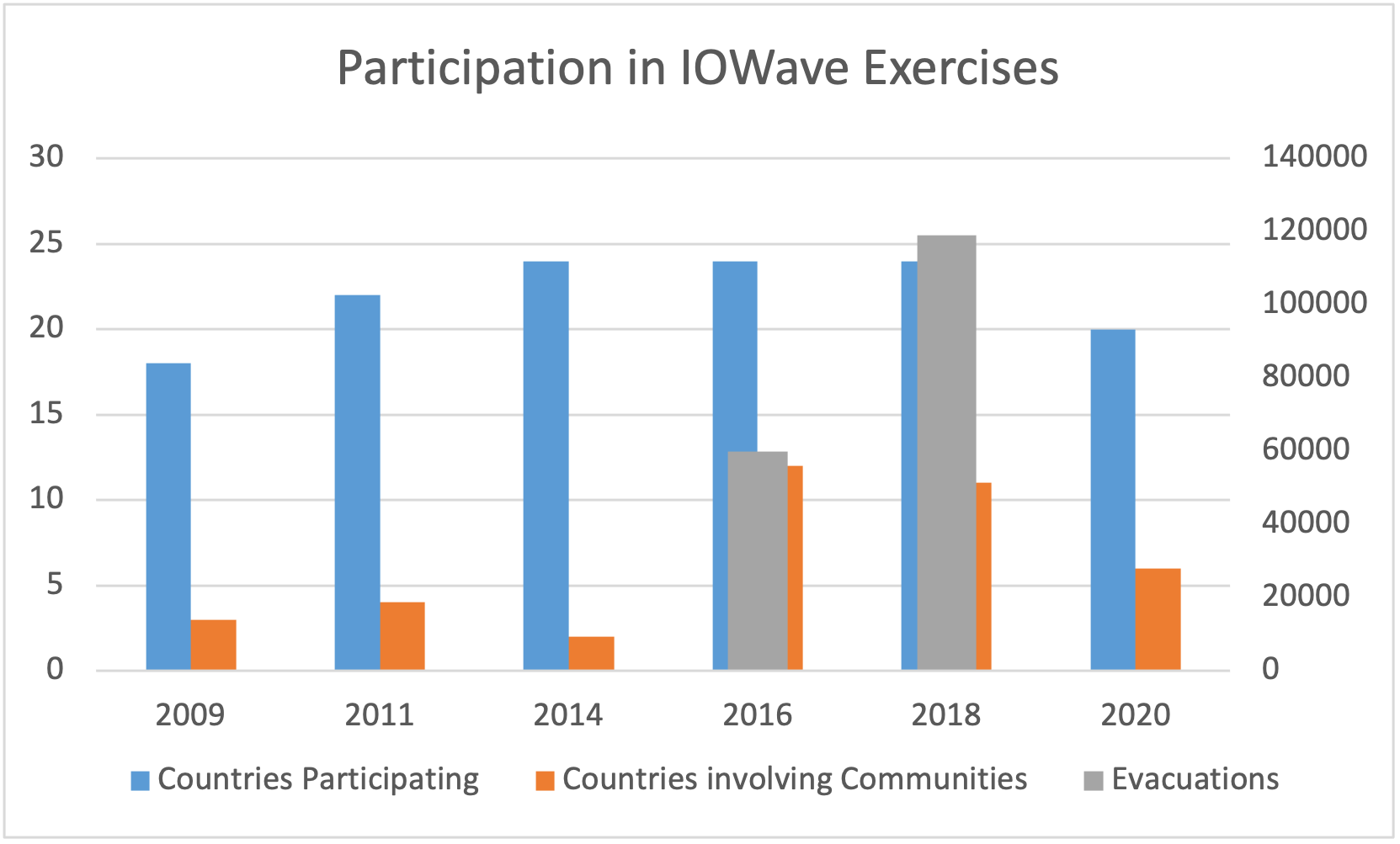 Figure: Country participation in IOWave Exercises: number of countries participating, number of countries involving communities and number of people evacuating.
Figure: Country participation in IOWave Exercises: number of countries participating, number of countries involving communities and number of people evacuating.
The Indian Ocean Tsunami Ready guidelines, in conjunction with the IOWave18 exercise, provided a mechanism for increasing community preparedness for tsunamis. During IOWave18, Tsunami Ready was piloted in six coastal communities in India and one in Oman. An additional eight Member States have assessed their tsunami preparedness against the Tsunami Ready indicators as part of the IOWave18 evaluation.
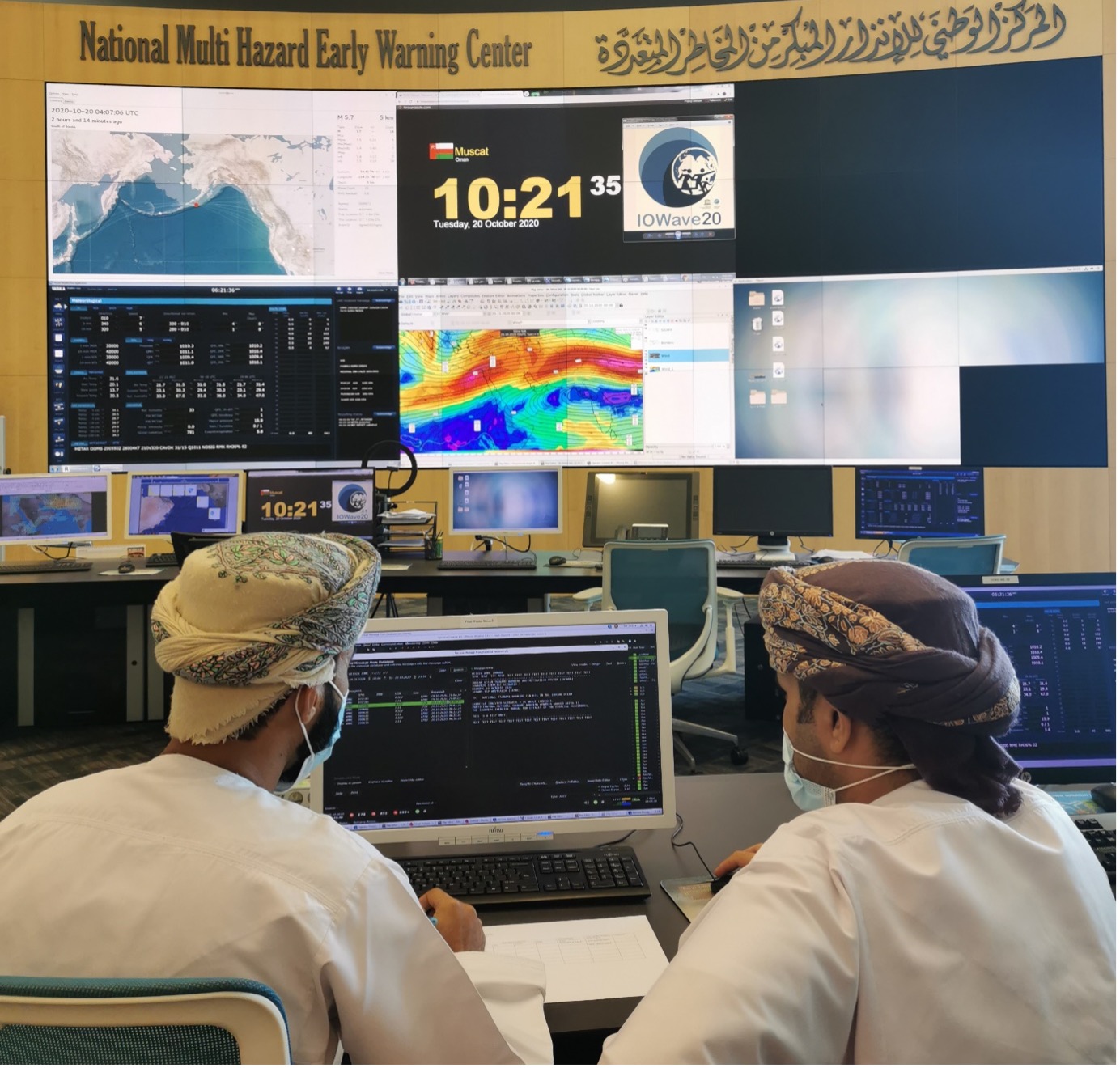 Scientists at the Oman National Multi Hazard Warning Center participate in Exercise IOWave20 (October 2020).
Scientists at the Oman National Multi Hazard Warning Center participate in Exercise IOWave20 (October 2020).
Social media is playing an increasing role in engaging with coastal communities both in preparation for and during the Exercises. Social media campaigns using platforms such as Twitter, Facebook and WhatsApp have gained momentum during recent exercises. Similarly, video footage of evacuations is becoming increasingly common. These trends reflect the recent adoption of such technology into society.
Exercising during a Pandemic
The most recent exercise, held in October 2020, was impacted by the ongoing Covid-19 pandemic. Nonetheless, at least twenty counties participated in IOWave20, with six reporting community involvement (i.e. Indonesia, Kenya, Mauritius, Mozambique, Seychelles, Thailand).
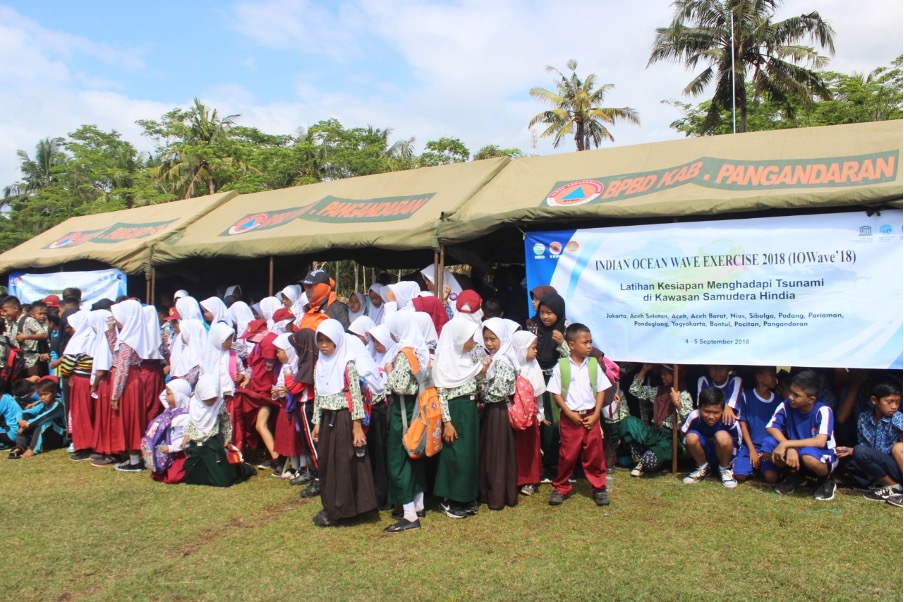 Evacuations in Pangandaran, Indonesia during Exercise IOWave18 (September 2018).
Evacuations in Pangandaran, Indonesia during Exercise IOWave18 (September 2018).
The IOWave20 Task Team carefully monitored the developing pandemic and decided it was in the best interest of Indian Ocean Member States to reduce the scope and scale of the Exercise. Member States were encouraged to test communications protocols and conduct virtual tabletop exercises, as a minimum, to assess organizational standard operating procedures, plans and policies for tsunami warning and emergency response in the backdrop of a pandemic. By exercising during pandemic conditions, Member States had the opportunity to validate existing business continuity plans and arrangements. In the future, the Task Team should develop guidelines for conducting a virtual tabletop exercise based on the experience of IOWave20.
Noting the interest of some Member States in engaging communities that are not impacted by the pandemic in Exercise IOWave20, the Task Team recommended that this should be at the sole discretion of the Member State considering their unique situation with respect to Covid-19. Member States were advised to individually assess any health risks in the backdrop of the pandemic and only then decide on the appropriate level of participation in IOWave20, ensuring that there is no interference with physical distancing measures already in place.
The ICG/IOTWMS published guidelines for tsunami response during the Covid-19 pandemic and the IOWave20 Task Team encouraged Member States to update their standard operating procedures for a pandemic situation. Five countries reported updating their tsunami response procedures during the pandemic. A further eleven countries reported that they have future plans to adjust their response procedures for a pandemic environment.
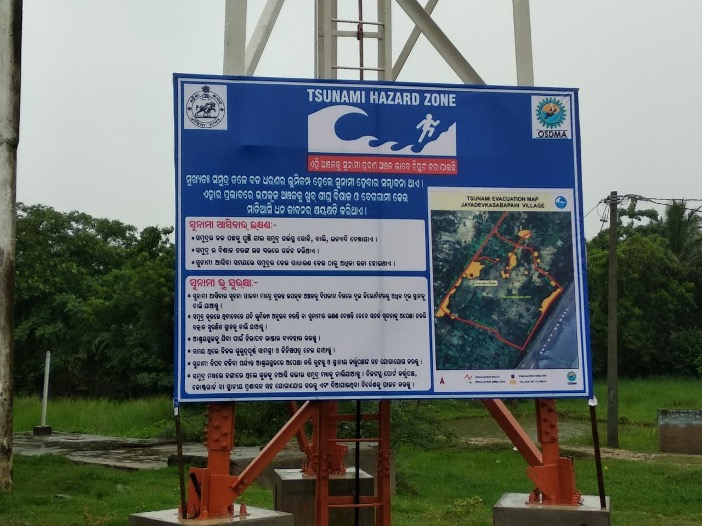 Tsunami Hazard Map displayed in Odisha, India (September 2018).
Tsunami Hazard Map displayed in Odisha, India (September 2018).
We must remember that a tsunami can strike at any time, even during a pandemic. Taking actions to prepare for tsunamis, including conducting regular tsunami exercises, will help nations and communities better respond during a real tsunami event and ultimately save lives.
By Nora Gale (UNESCO/IOC ICG/ITOWMS Secretariat), Ardito M Kodijat (Indian Ocean Tsunami Information Centre (IOTIC) UNESCO/IOC), Weniza (The Agency for Meteorology, Climatology and Geophysics, Indonesia), Ali Khoshkholgh (Iranian National Institute for Oceanography and Atmospheric Science), Ajay Kumar Bandela (Indian National Centre for Ocean Information Services), and Simon Allen (Australian Bureau of Meteorology)


